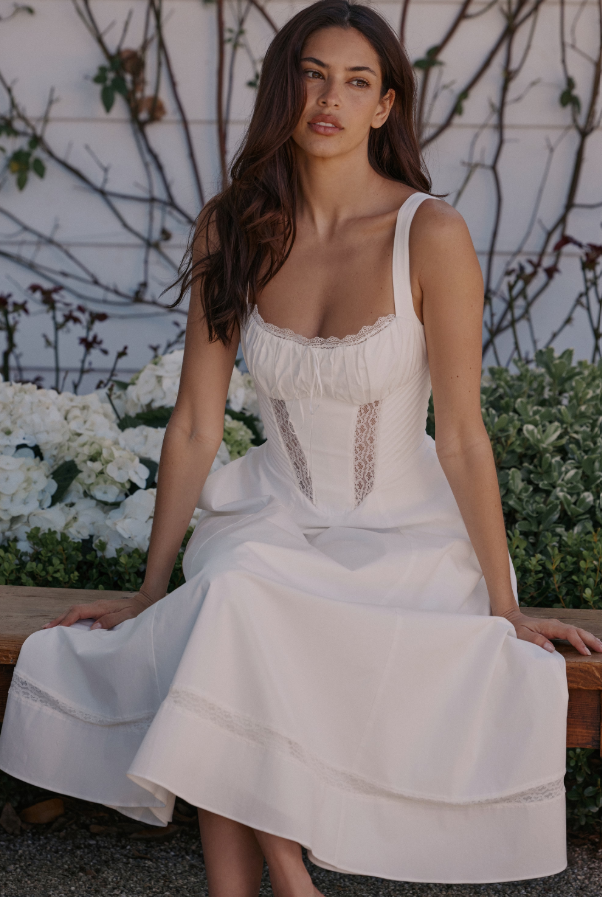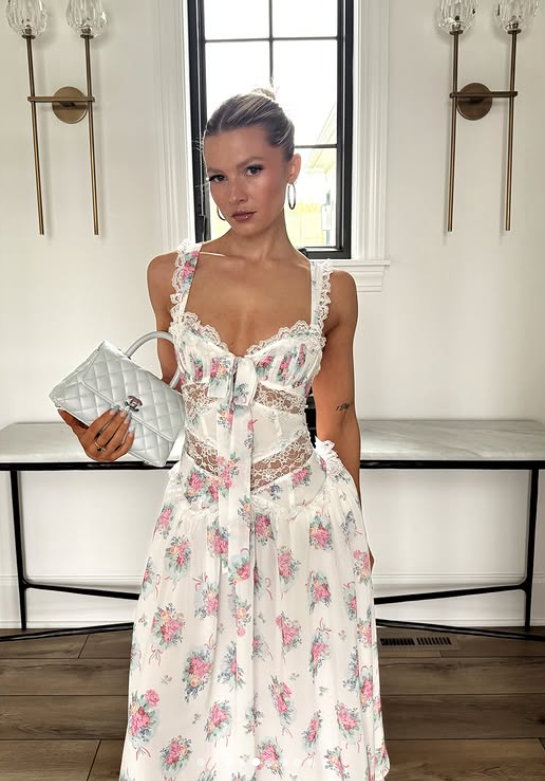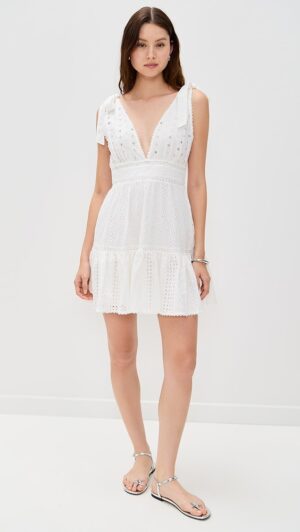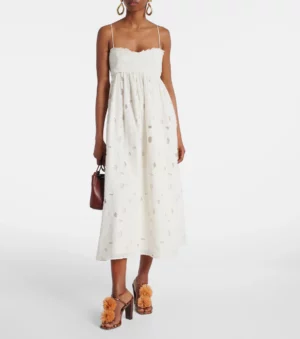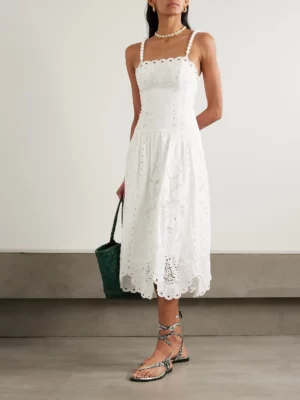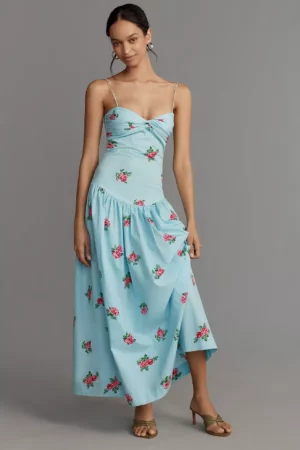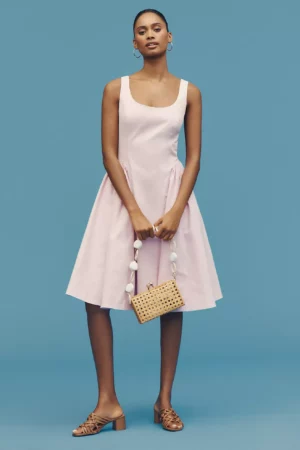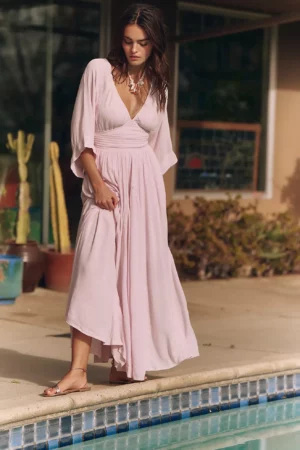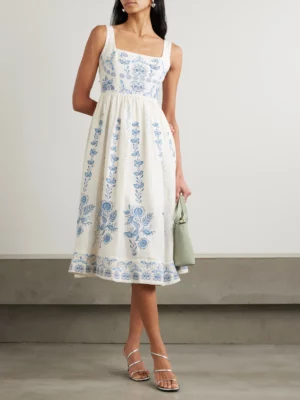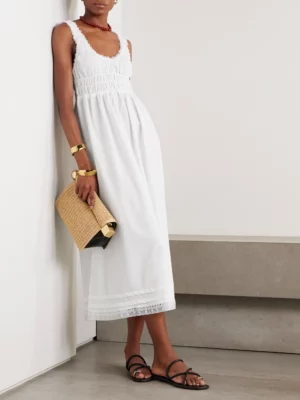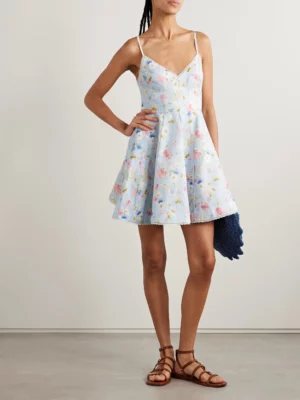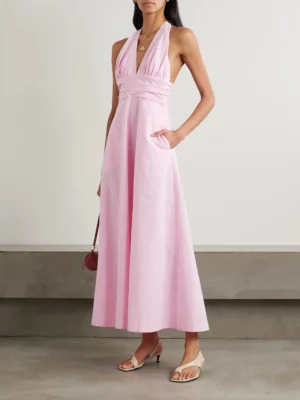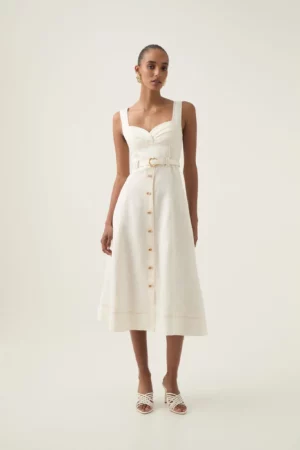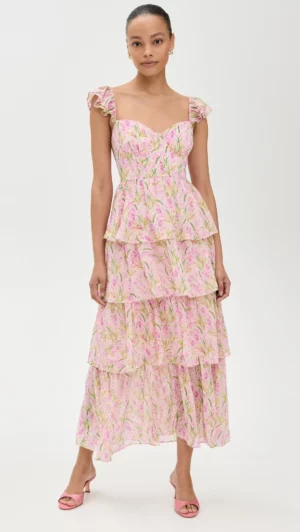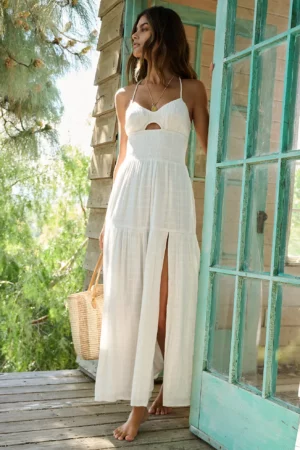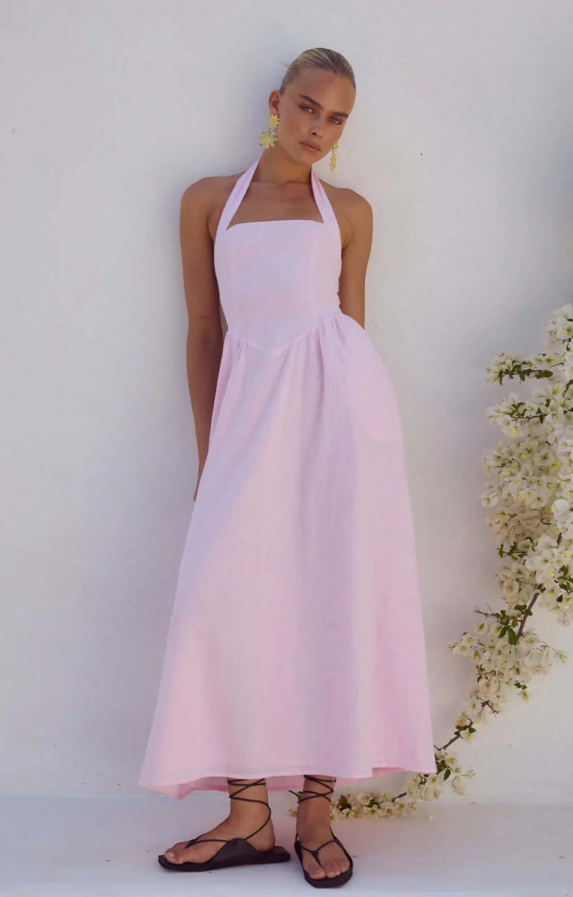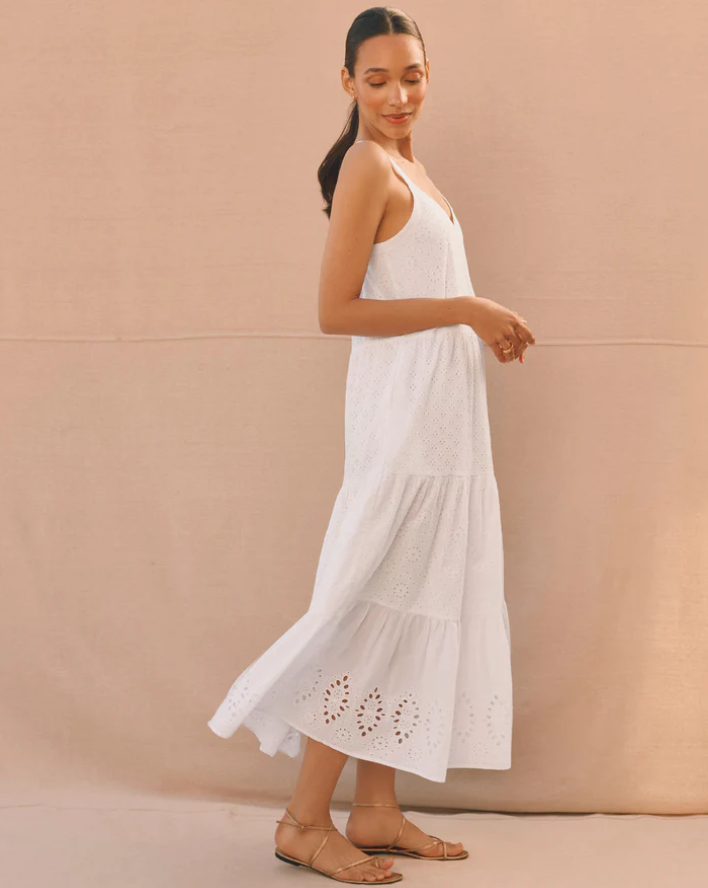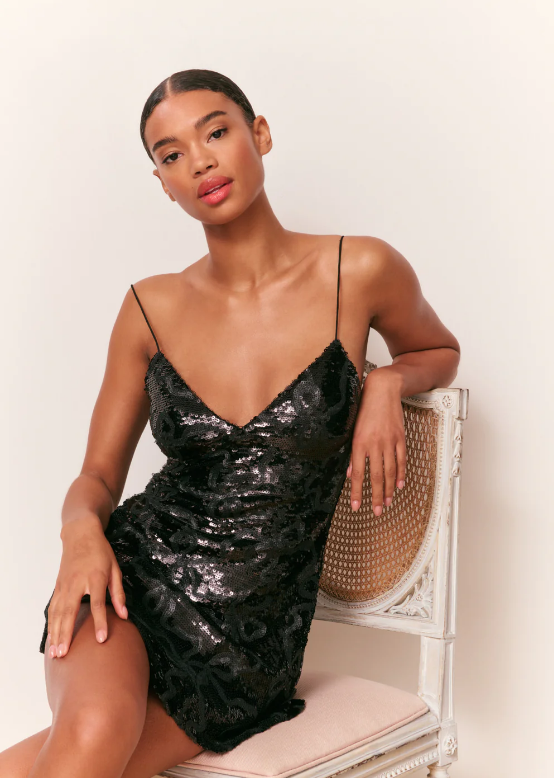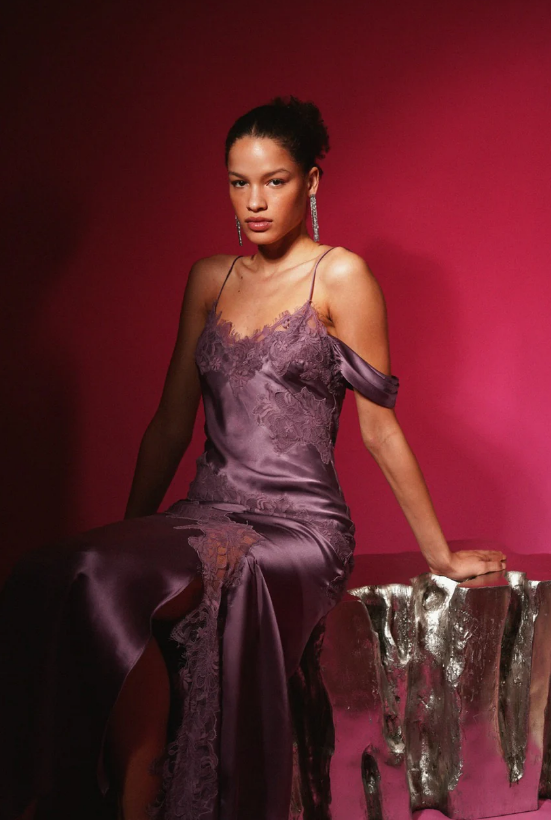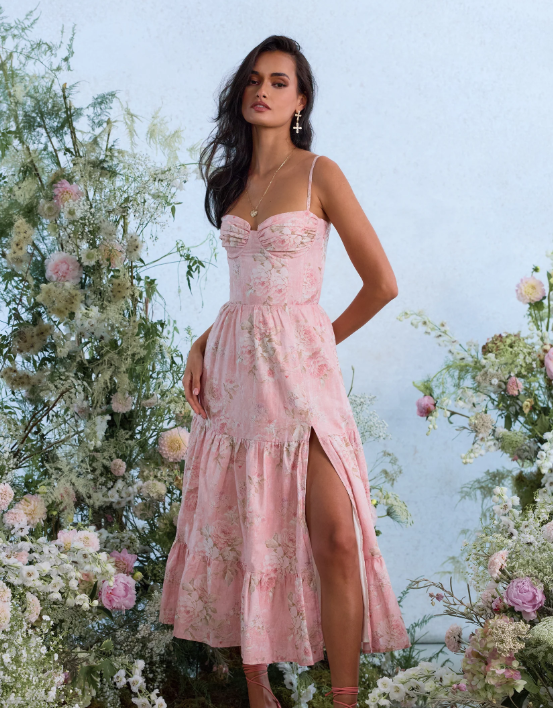
V.Chapman
Paris to Postiano: European Summer Dresses Fashion Insiders Swear By
This summer, I packed my carry-on with sunscreen, sandals, and a simple mission: to develop a better understanding of the obsession with European summer dresses. You know the ones — romantic, breezy, sun-drenched silhouettes that seem to follow you across the continent, from balcony breakfasts in Paris to Aperol-fueled sunsets along the Amalfi Coast. Still, beyond the social media charm, I wanted to know what these dresses mean. Why do we keep coming back to them, season after season, like some kind of summer ritual?
In fact, I can still remember the first time I fell in love with a dress. I was eight, it was July, and my grandmother had just pulled a floral cotton frock from the back of her closet. It smelled faintly of lavender and sun-dried laundry, and I was immediately mesmerized. “This,” I thought, “is how summer should feel.” Ever since then, I’ve been chasing that feeling — the float, the romance, the way the right dress can make you feel like you belong in a Monet painting.
So yes, I’ll admit it: I’ve been obsessed with European summer dresses my whole life. To me, they’ve never been just clothes — they’re a memory, mood, and escape all wrapped into one garment.
Exploring the Charm of European Summer Dresses
Every summer, like clockwork, I find myself curating a Pinterest moodboard. For example, there’s always the white eyelet dress for late afternoon café lingering in Paris, the silky floral wrap number that feels right in the Balearics, and something vintage and citrus-printed for the Amalfi coast — even if I’m just wearing it to a backyard barbecue. I’ve always believed the magic of a European summer dress isn’t about geography; it’s about intention.
This year, I finally decided to follow the thread — literally. I planned my summer tracing the invisible map that lives in my closet: Paris, Lisbon, Positano. Rather, I wasn’t looking for trends. I was looking for the women — and the stories — behind the dresses I’ve adored for so long.
Stitched With Memory: What Europe Taught Me About Dresses and Meaning
In Paris, I found myself chatting with Clémence, a stylist who believes in having fewer, better things. Interestingly, she wears three dresses every summer, all inherited or found in tucked-away flea markets. “The older the dress, the more soul it has,” she told me. I nodded, thinking about the way certain cottons feel like they carry the laughter of decades. We drank Parisian coffees as she told me about repairing hems with invisible stitches and wearing the same wrap dress to weddings and walks along the Seine. There’s something deeply French about the quiet confidence of wearing the same dress often — as if repetition is its own kind of elegance.
I was in Positano when everything clicked. There, the air was thick with lemons and saltwater, and every other woman seemed to be floating around in linen that caught the breeze. I stopped a woman wearing a lemon-printed sundress with a braided open back. “Where’s it from?” I asked. She smiled: “I made it. My nonna taught me to sew.” Of course she did.
And maybe that’s the thing — my obsession with European summer dresses has never really been about fashion. It’s always been about emotion. Memory. Texture. Slowness. And beyond all that, the way slipping into a well-made dress can instantly shift your posture, pace and even your point of view.
What Celebs in Europe Are Really Wearing This Summer
When Dua Lipa posted photos of her vacation in the South of France earlier this month, I paused on one frame: her in a white off-the-shoulder Jacquemus dress, the fabric fluttering like an invitation in lavender fields. But it wasn’t showy—it was cinematic.
And then some days later, I saw Kendall Jenner in Mallorca, enjoying on a yacht in a lavender turtleneck backless Khaite gown, the sea morphing its hue as the sun passed overhead. Luxurious, yes—but there’s poetry in choosing a single, standout piece for the whole day. It made me question: why grab five fit-and-flares when one ethereal dress might say it all?
At Cannes—and later Capri—Rosie Huntington‑Whiteley was seen in a butter-yellow Jacquemus mini dress, looking sleek and sun‑soaked, paired with minimalist accessories. That shade, that silhouette—it wasn’t screaming style. It was whispering confidence. A lesson: the right color and shape can feel both effortless and intentional.
Over on the Amalfi Coast, Sydney Sweeney wore a blue floral one‑shoulder mini dress by Saint Laurent, styled with strappy sandals and a candy‑pink Givenchy tote. That small floral print felt like a love letter to the region—cheerful, feminine, and rooted in place.
-
ULLA JOHNSON Marina Floral Cotton Organdy Midi Dress
$1,340 -
FARM RIO Richelieu Scalloped Gathered Broderie Anglaise Midi Dress
$348 -
S/W/F Sleeveless Sweetheart Drop-waist Maxi Dress
$388 -
ANTHROPOLOGE Sleeveless Scoop-neck Basque-waist Midi Dress
$118 -
FREE-EST Dixie Maxi
$118 -
AGUA BY AGUA BENDITA Miramar Floritura Gathered Embroidered Linen Midi Dress
$1,550 -
FAITHFULL Juliet Bow-embellished Lace-trimmed Shirred Cotton-poplin Midi Dress
$250 -
ZIMMERMANN Lucky Lace-trimmed Floral-print Linen Mini Dress
$625 -
BERNADETTE Marilyn Striped Cotton Halterneck Maxi Dress
$895 -
AJE Primary Belted Midi Dress
$475 -
ASTR THE LABEL Midsummer Dress
$168 -
LSPACE Calla Midi Dress
$169 -
HOUSE OF CB Dorothy Floral Dress
$269
The Summer Dress Edit Europeans Actually Wear
This summer, I traced the softly lit terraces of Europe, talking to real women and influencers about the summer dresses they live in—not just post in. I wanted to know: what makes a dress worth packing? And how do we balance beauty with intentionality?
Linen as a Lifestyle
In Milan and Paris, I spotted linen dresses everywhere. Every influencer seems to lean into the minimalist elegance of a linen shirtdress or maxi, often in white, camel, or olive—colors that echo coastlines and cityscapes. These are the dresses that Instagram editorials swear by: breathable, effortless, and grounded in craftsmanship
Crochet Cover‑Ups & Weaves
Then we have crochet that has taken over beach-to-street style. From Zara minis to high-end versions by Reformation and Missoni, open-knit and crochet dresses are everywhere—poised over bikinis, but styled as main outfits too. European influencers pair them with woven totes and sandals, proving a cover-up can double as a confident statement dress.
Pastel Smocked Minis
On fashion-savvy feeds across Instagram, I see pastel smocked dresses everywhere—think ballet pink, butter yellow, pistachio green. Brands like Staud, Victoria Beckham, and Chanel showcased them on runways, and influencers are translating them into laid‑back city style, often with minimalist accessories.
Vintage Revival & Patchwork Prints
Cottage-core romantics and vintage lovers are reviving antique florals and patchwork silhouettes. European thrift finds and sustainable labels are being worn by influencers like Doina Ciobanu, who champions mindful fashion. Her approach—wear once, resell thoughtfully—underpins how nostalgia and sustainability can coexist.
The Quiet Power of the Floral European Summer Dress
Now onto my favorite type of European summer dress: pretty florals. There’s something about slipping into a floral dress in Europe that feels like returning to yourself. Maybe it’s the gardens — overgrown, unapologetic. Or it’s the contrast of soft blooms against old stone. Or could it be because the floral dress doesn’t scream to be seen, but is still never overlooked.
Unlike the mass-produced daisy prints that flood fast-fashion every spring, the European floral summer dress feels more like a love letter to place and past. In Lisbon, I found block-printed cotton dresses dyed with natural pigments; in Florence, antique markets offered 1940s tea dresses with worn collars and perfectly faded violets.
They’re rarely loud. On the contrary, they whisper muted pastels, scattered wildflowers, and hand-drawn vines that feel plucked from an old sketchbook. The women wearing florals here are less trend-driven and more intuitive. A French model I met in Marseille described her go-to dress — a washed-linen wrap with tiny cornflowers — as “my second skin in summer.” She doesn’t post about it. She just wears it until her desires. It’s a pattern of intention: to repeat, rewear, reimagine.
On the Amalfi coast, floral dresses float. They’re often seen with hair tied back, flat sandals, a market basket, and no filter in sight. But they’re also layered under denim jackets in the city, or worn with boots on cool days — because here, dresses aren’t seasonal; they’re stitched into lifestyle.
The Fashion Crowds Take on European Summer Dresses
If you ask any fashion editor worth their sea salt spray what they’re loving this season, chances are the answer will revolve somewhere around the phrase “European summer dresses.” It’s become a fashion code for a particular kind of effortlessness—think sun-faded florals, gauzy linens, and the kind of undone elegance you imagine spotting in a Rossellini film or a Jacquemus campaign.
Stylist Rachael Wang calls it “the soft power of summer.” In a recent interview, she described European summer dresses as “emotionally charged garments,” which sounds dramatic until you’re actually wearing one in 90-degree heat. It’s less about the dress itself and more about how it moves with you—breezy, tactile, free.
Vogue fashion news writer Laia Garcia-Furtado recently called the European summer dress “a walking moodboard,” signaling to how it blends nostalgia with practicality. “It’s cottagecore without the cosplay,” she wrote, “French girl without the clichés. The clothes don’t scream, they whisper—mostly in Italian or maybe Provençal.”
In the end, the European summer dress isn’t just a piece of clothing—it’s a feeling. It’s what you reach for when you want to feel like yourself, only lighter. Whether you’re wandering through a Sicilian market or just sitting at a beach club with a glass of something cold, it carries with it a sense of place, of presence. It’s not about chasing perfection, but about wearing something that breathes with you. And in a fashion world that’s constantly speeding up, that kind of stillness feels radical.
